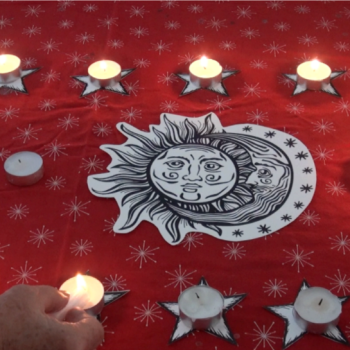Now, about the hero Perseus
Many people see Perseus as the hero of the story: he is the one who conquers and kills Medusa, he is the one who overcomes Atlas. But we didn’t feel Perseus was a hero, so much as we felt that Perseus was a bully who wassn’t even very bright. As it turns out, our feeling about Perseus was anticipated by Pelaephatus, an ancient Greek writer. Pelaephatus was a religious naturalist — that is, he did not believe in supernatural explanations for religious matters. As a religious naturalist, Pelaephatus could not believe that Medusa’s head actually turned people to stone. Instead, he explained the story as follows:
“When he got his hands on the Gorgon, Perseus cut it in pieces; then, by way of fitting out his trireme, he put the head of the Gorgon on it and thereafter called the ship by the name ‘Gorgon.” Sailing around in this ship he exacted money from the islanders and slew those who refused to give. In this way he sailed eventually against the people of Seriphos and demanded money from them. They in turn asked for a few days time in which to collect the money. But instead they brought together and set up man-sized [sic] stones in the marketplace and then abandoned the island of Seriphos. Perseus sailed back to demand his money, but when he came into the marketplace he found no men but rather the man-sized stones. Thereafter, whenever any of the other island people would not pay their tribute, Perseus would say: ‘Be careful that you too do not suffer what the people of Seriphos did, who say the Gorgon’s head and were turned to stone.’” (6)
In other words, Perseus was a thug, a murdering bully who traveled from isaldn to island extorting money from innocent people. Not only that, but it appears that Perseus was so stupid he didn’t even realize that the people of Seriphos had tricked him.
In short, we feel that in the story of Perseus and Medusa, the hero Perseus isn’t at all heroic. The monster Medusa, on the other hand, is a figure of power, and a personage worth knowing — not in the least because knowing Medusa can help us to understand ourselves.
Notes:
(1) Robert Graves, The White Goddess, amended and enlarged edition (New York: Farrar, Strauss and Giroux, 1948), p. 231.
(2) Emily Culpepper, “Ancient Gorgons: A Face for Women’s Contemporary Rage,” (Cambridge, Mass.: Woman of Power: A Magazine of Feminism, Spirituality, and Politics, 1986), reprinted in: Marjorie Garber and Nancy J. Vickers, ed., The Medusa Reader (New York: Routledge, 2003), pp. 243-245.
(3) David Leeming, Medusa in the Mirror of Time (London: Reaktion Books, 2013), p. 76.
(4) Dorothea Smartt interviewed by Lizbeth Goodman, “Who’s Looking at Who(m): Re-viewing Medusa (1996), reprinted in Garber and Vickers, pp. 261 ff.
(5) May Sarton, A Grain of Mustard Seed: New Poems (New York: Norton, 1971), p. 38.
(6) Pelaephatus, “The Daughters of Phorcys,” trans. Jacob Stern, On Unbelievable Tales: Translation, Introduction, and Commentary (Wauconda, Ill.: Bolchazy-Carducci Publishers, 1996), p. 63.
[This article’s author, Dan Harper, is the Assistant Minister of Religious Education at the Unitarian Universalist Church of Palo Alto, California (UUCPA). He writes: I live with my partner of more than twenty years, Carol Steinfeld, who is a writer specializing in ecological pollution prevention issues, particularly water and wastewater. Before I became a minister, I worked as sculptor’s apprentice, warehouse help, salesperson, carpenter, clerk in a health food store, and director of religious education. I sing regularly at Bay area Sacred Harp singings, and with the San Francisco Rockin’ Solidarity Labor Heritage Chorus.]















